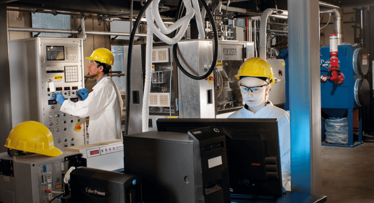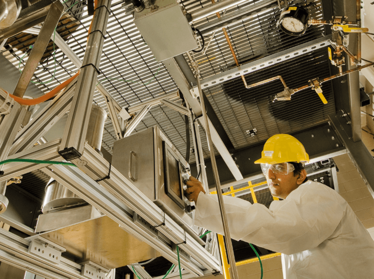Continuous Progress
Resistance is futile – big pharma has spoken and continuous manufacturing will be in commercial use in the near future. But let’s not stop there – now it’s time to explore the full potential of the technology.

Implementation of continuous manufacturing (CM) is long overdue in pharma. High margins and intense regulatory scrutiny has left us lagging behind other industries. But as the market gets tougher and regulators make it clear they want to see more sophisticated manufacturing, the roadblocks are crumbling. Change is coming, like it or not.
The advantages are well documented, both in terms of improved quality and lower costs. Because you’re working with a much smaller amount of material at any one point, scrutiny and control of the process is enhanced. On the cost side, the biggest savings come from improved efficiency, reduced batch rejection, faster production and fewer staff.
There are also huge savings to be made in development. For example, here at the Engineering Research Center for Structured Organic Particulate Systems (C-SOPS), we worked with one company to develop a continuous process for an existing product. To carry out design of experiments (DOE) for the process using a batch model required around 4000 kg of active pharmaceutical ingredient (API); a continuous process cut that down to 150 kg. Given that the API in question carries a price tag of up to $10,000 per kg, it was a huge saving. Savings of this level more than cover the capital expense of a new facility and manufacturing line.
Another area where CM comes into its own is in combination products. We recently worked on a project involving a combination product with six different dosage ratios, with impressive results. In a CM line you can switch between dosage ratios in real time – there’s no need to shut down and re-calibrate – it’s as simple as entering a command into your control system.
What’s the hold up?
I still run into some industry veterans who believe that CM will never enter the mainstream. Beyond a general resistance to change, there are some valid reasons for caution. CM may not be right for everyone, at least not right now. There is an obvious benefit–cost analysis to be made with regard to capital equipment, and the savings won’t stack up for every product at every company. So where is CM most cost-effective? Two types of production are generally considered obvious targets for a continuous approach: large-volume manufacturing, where small per-pill savings add up quickly; and new products, where development costs can be substantially reduced. Facilities producing medium- or low-volume products already on the market are unlikely to be early adopters.
For smaller companies, the cost of equipment is a major factor. But I believe the biggest roadblock to implementation is regulatory uncertainty. The whole ethos of CM is very different as compared to a standard batch approach, and there is continued apprehension from some companies that the regulators aren’t going to welcome these new methods. In particular there is uncertainty about how regulatory bodies beyond the FDA, EMA, and Japan’s PMDA will respond. At this point in time, there is no regulatory guidance specifically for CM. Instead, people are looking at the existing guidance and trying to understand how that applies to CM, which sometimes causes confusion. One thing people always ask is, “If I’m doing a continuous process, how do I define a batch?” If you look closely at the guidance, the definition of a batch doesn’t exclude CM – a batch is simply the amount of product you would recall – but any uncertainty is unsettling for companies who stand to lose huge sums if approval is delayed.
For their part, the FDA see CM as a way of improving quality and getting more breakthrough therapies to patients. They know that there is a desire from the industry to move forward, but that aspects of the regulatory process are causing hesitation, so they have asked C-SOPS and our collaborators to help them put together some initial guidance specifically for CM. The role of the Center will be to facilitate the process and provide technical input. By speaking with company and academic experts early on, they hope to avoid releasing potentially unclear guidance, as with PAT and QbD, with uncertain implementation direction resulting in slow adoption.
Both parties want to move faster, but the knowledge base on both sides is the sticking point. The academic research we and others have done in the past few years has filled in many of the gaps in our knowledge – now we just need to keep the conversation going between industry and regulators.
Don’t stop me now
Ultimately, companies with the motivation and resources to pursue CM are not put off by the (real or perceived) regulatory or financial hurdles. Big pharma are the first-wave adopters and all the major companies have emerging or ongoing programs at this time. There has been slow and steady progress in CM over the past decade, but in the last year and a half the pace has picked up dramatically, as several companies have made big strides towards commercialization – companies like Vertex Pharmaceuticals, who are now working with the FDA to get approval for their 4,000-square-foot continuous manufacturing facility in Boston.
Once these trailblazers have safely negotiated the regulatory pathway, a larger second wave of adopters will follow in their footsteps. That tipping point is getting ever-closer, as evidenced by a change in the number and type of people contacting us to discuss working with the Center. In the past three or four months, we have started to get calls not only from research and development departments in big pharma, but also from regulatory departments and even generics companies – no-one wants to be left behind.
Continuous control
The ability to model processes and predict outcomes is one of the most powerful aspects of CM. This is easy to see in the petrochemical industry. An oil refinery needs to be able to work with different feedstock and still produce the same quality of gasoline, diesel, and so on. Operators use advanced modeling to adapt the process to the feedstock and desired end-product and continuously monitor quality. The problem with applying those models to a pharmaceutical plant making solid oral dosage forms is that historically the flow chemistry of liquids has been much better understood than that of powders. To be able to model powders effectively, a lot of additional research was needed, both from academic centers like ours and from software companies. There is still work to do, but we now have tools that are very similar to those in the petrochemical industry, which will save time and money by validating the process in advance, and make the FDA’s work easier by flagging potential risks.
In batch manufacturing, the ingredients may spend upwards of two weeks in the production cycle, with checks between each step, whereas in CM there may be as little as 5–10 minutes between the product entering the system and the tablet being formed. The window for identifying any problems is much shorter. To maintain process efficiency and product quality, you need continuous monitoring and feedback, like the smart sensors found in modern cars that keep you in the proper lane. The big question now is how much of this control is needed to keep the process safe. It all comes down to risk: the more risks associated with the product, the more monitoring is required. For an over-the-counter medicine you wouldn’t need the same degree of sophistication in control systems as you would in a highly potent drug. But exactly where those boundaries lie is an area of discussion with regulators.
C-SOPS has several research programs focused on advanced modeling. One of our newer exciting projects is building a material properties database for CM. Companies focused on breakthrough therapies are very interested in the ability to design formulation space. By having access to information about the material properties of a large number of excipients and APIs and their behavior in a CM process, the database will allow us to model how a new API is likely to behave in a given formulation. When working with a very expensive API, we can characterize its material properties from a small sample, and identify a cheaper ‘stand in’ material for use in early-stage process development.
Academic acceleration
We believe academic institutes like ours have a key role to play in harnessing the potential of CM. C-SOPS is the world’s largest academic-led research organization dedicated to pharmaceutical manufacturing. By combining their resources, the 40-plus industrial consortium members can advance the field at a much faster pace than they could individually – in addition to aligning their efforts so that regulators have a single, unified approach to work with.
We recently received a new round of funding from one of our long-term collaborators, Janssen, to continue what has already been a very fruitful partnership. Around seven years into the life of the Center, we launched a project with funding from Janssen and the National Science Foundation, to design Janssen’s first continuous direct compression process. We designed and built a full-scale CM plant at Rutgers University, which was used as a model for Janssen’s plant in Puerto Rico. The Puerto Rico facility was built just a year later and is now being submitted to the FDA for approval. Together with pilot plants at Purdue University and the University of Puerto Rico, building a production-scale plant from scratch has been invaluable in terms of technical lessons learnt; the model plants are now being used by other companies to refine their own plans.

Aside from the teething problems you might expect when using new equipment, the build of the model plant went very smoothly. We were able to confirm the efficiency of CM and show that the continuous direct compression process is much more versatile than the equivalent batch process. CM keeps segregation to an absolute minimum and we were able to run the process with extremely highly segregating materials, while keeping relative standard deviation values well within acceptable levels. From our experience with the model plant, we concluded that somewhere in the region of 80 percent of pharmaceutical products could be made by direct compression – another financial driving force for CM. We’re now starting trials in wet granulation, a more complex proposition.
Looking towards the future, the increasing trend for more targeted therapies may bring new challenges for CM. A continuous process is less appealing for smaller-volume manufacturers, due to the time and cost of cleaning out the equipment between products and the challenge of maintaining accuracy when working with small quantities; when you have 1000 kg per hour running through the system, a gram or two either way is irrelevant, but as quantities come down the margin of error tightens. We’ll need to focus more effort onto this aspect to keep CM relevant for very small-scale production (as often needed in the early development phases) and in the growing area of personalized medicine.
There is nothing from a regulatory or technical standpoint, at least in the US or Europe, to stand in the way of CM. Two years ago, companies might have been able to treat CM as an off-shoot – something to keep an eye on. But with new research making the process ever-more efficient – and major pharma companies announcing plans to move 80 percent of their production to CM over the next five years – now is the time to get off the fence and get planning. You don’t want to be left behind.
Senior Manager, Continuous Manufacturing Business Development, Oral Solid Dose Pharma Services, Thermo Fisher Scientific, Greenville, North Carolina, USA



















